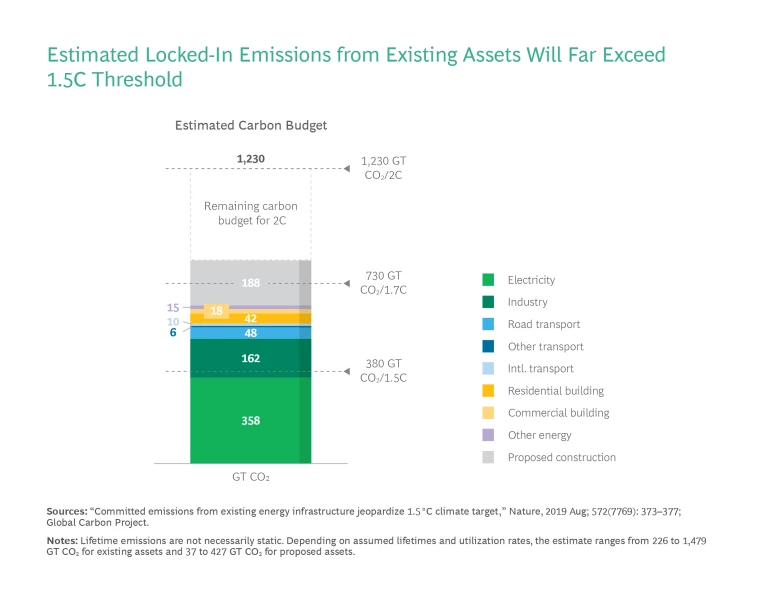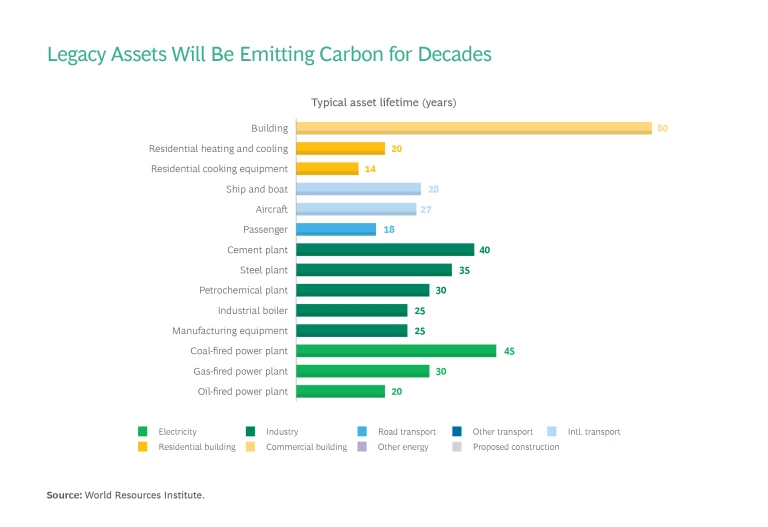Today’s global energy transition investment—$1.1 trillion in 2022—is largely aimed at reducing emissions generated by future equipment and facilities. This includes shifting auto production to electric vehicles (EVs) and building new renewable power sources. Yet this monumental effort has a risky blind spot: locked-in emissions. These are generated by existing infrastructure and equipment such as power plants, industrial furnaces, residential heating, airplanes, and the millions of internal combustion engine cars on the road today.
This substantial source of CO2 receives relatively limited investment and attention as the world appears poised to surpass the 1.5 degree warming limit. A quick look at the numbers reveals the magnitude of the locked-in emissions problem.
Existing infrastructure and equipment, if used for their typical lifetimes, will generate roughly 658 GT
The bottom line: there is no path to preventing the worst impacts of climate change without tackling locked-in emissions.
The scale of the challenge—and the solutions to tackle it—vary by sector. In this article, we take a closer look at the role of gas-powered vehicles. It may seem the solution for auto emissions has arrived, with EV sales taking off and the entire industry shifting aggressively toward electrification. Meanwhile, government action continues to drive momentum, including through recently proposed rules from the US EPA aimed at slashing auto emissions substantially. Yet by 2035, projections suggest there will still be 1.3 billion internal combustion engine (ICE), diesel, or emissions-generating hybrid vehicles on the road.
That stubbornly high figure makes the auto sector a powerful case study on how to address locked-in emissions. BCG’s assessment of the auto emissions problem identified key private and public sector actions centered on four existing levers: nudging consumer behavior, technological intervention, policies and regulations, and creative financing. Our analysis found that accelerating and expanding the use of these levers can cut locked-in emissions from autos roughly in half. The remaining emissions must be addressed with a push for further innovation within each lever.
Enterprising institutions in both sectors will find similar opportunities in other areas that have significant locked-in emissions. Companies that act aggressively on both levels—ramping up known solutions while pushing for innovation—will help society address a critical
climate and sustainability
challenge while creating real sustainable advantage.
The Emissions Hiding in Plain Sight
Increasing investment in green technologies today is driven by the attractiveness of burgeoning green markets, policy incentives (such as those in the US Inflation Reduction Act), heightened regulation (such as the EU taxonomy driving implementation of the European Green Deal), and a global energy crisis. Although this suggests strong tailwinds for the climate transition, current investment remains woefully insufficient to achieve net zero by 2050; estimates suggest global energy transition investment must reach $4.55 trillion per year to remain on track. And even if capital flows accelerate, there is no indication they will be directed toward addressing locked-in emissions.
Much of the discussion around this issue focuses on power generation—and rightly so, as it’s by far the largest contributor. (See “The Focus on Electricity Generation.”)
The Focus on Electricity Generation Emissions
That’s why significant attention is being paid to decarbonizing electricity generation. More than 40 countries have agreed to ban the development of new coal power, and 200 countries plan to phase out the use of coal. In the US, the Biden administration recently announced limits on emissions from existing power plants with the aim of eliminating emissions from the US power sector by 2040. Even natural gas, once heralded as a clean transition fuel, is receiving increased scrutiny as the EU plans to call for a phase-out of all fossil fuel emissions at COP28 in late 2023.
Yet, despite low-cost alternatives and political will, the global development pipeline for power includes 537 GW of new coal and 615 GW of natural gas. These assets will require retrofits—for example, with carbon capture, utilization, or fuel substitutes such as ammonia or hydrogen. Or they’ll become stranded. Or they will continue to emit emissions for the next 30 to 45 years. As with each category of locked-in emissions, innovation is needed to ensure the installed base in power generation does not jeopardize the achievement of net zero.
But locked-in emissions from other infrastructure and equipment categories are significant enough to threaten efforts to limit global temperature increases, reduce water stress, and minimize biodiversity loss. The locked-in emissions challenge is a function in large part of the long lifetimes of many carbon-emitting assets. For example, a cement plant has a typical lifetime of 40 years; an aircraft, 27 years; and a building, 80 years. (See Slideshow.)
The auto sector can be examined to highlight the magnitude of the problem. ICE vehicles have a typical lifetime of about 18 years. All told the sector is expected to produce cumulative emissions of roughly 30GT CO2 by 2035—about 10% of the carbon budget to reach 1.5°C. (See Exhibit 1.)
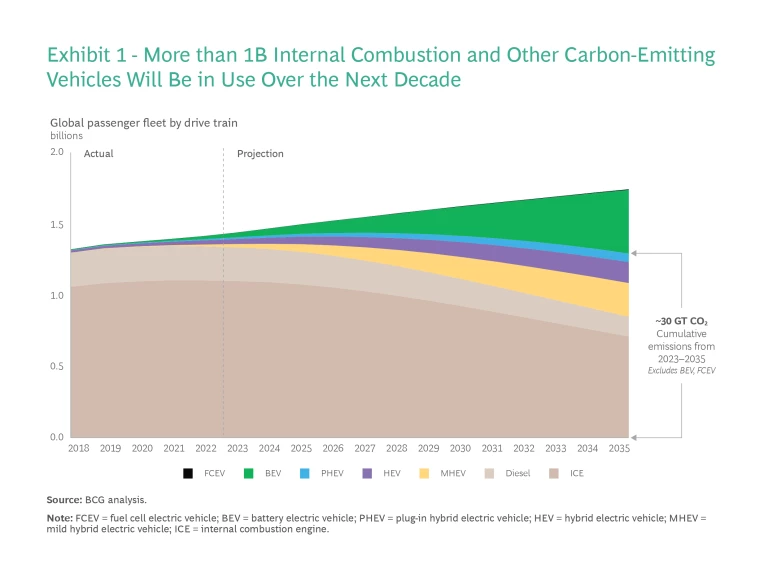
These ongoing ICE auto emissions will be increasingly tied to the used car market. More than 100 million used cars were sold in 2019, and the market is growing at roughly 6%. Current trade patterns show that used American, Japanese, South Korean, and European cars tend to flow to countries throughout Africa and Asia. (See Exhibit 2.) In fact, Africa is the final destination for roughly a quarter of used cars, and Asia Pacific another 12%. And although the used car market can help accelerate access to hybrid and electric vehicles in some markets, the uptake of such vehicles will be slow in regions that have limited charging infrastructure. Ultimately, moving used ICE vehicles to different markets—and not addressing their continued high emissions—is a major impediment to achieving net zero.
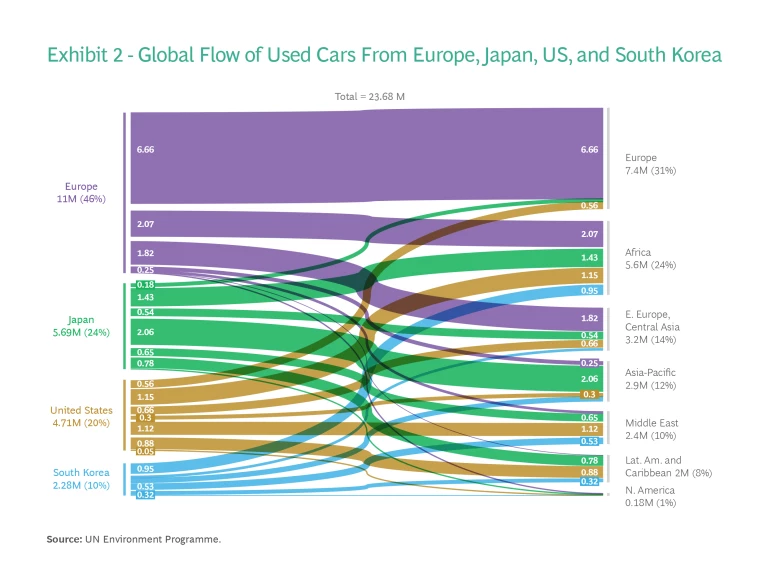
Used car market dynamics also create potential issues from the perspective of an equitable energy transition. Currently, no international treaties govern the sale of used cars, and older cars that move to new markets emit more pollution, are sometimes less safe, and can be more costly to maintain. In addition, regulations regarding safety and emissions standards in Africa and Asia tend to be among the weakest.
Tackling Locked-In Emissions in Cars
Steps are being taken today to bend the curve on locked-in auto emissions. We see existing solutions within the four primary levers that, if more aggressively deployed, could move the needle significantly. (See Exhibit 3.) Nevertheless, our analysis finds that we will fall short of eliminating locked-in emissions within the automotive sector if we rely solely on these existing solutions. The answer: innovation. Across each of these levers, sources of untapped potential can further reduce these emissions while creating new value pools.
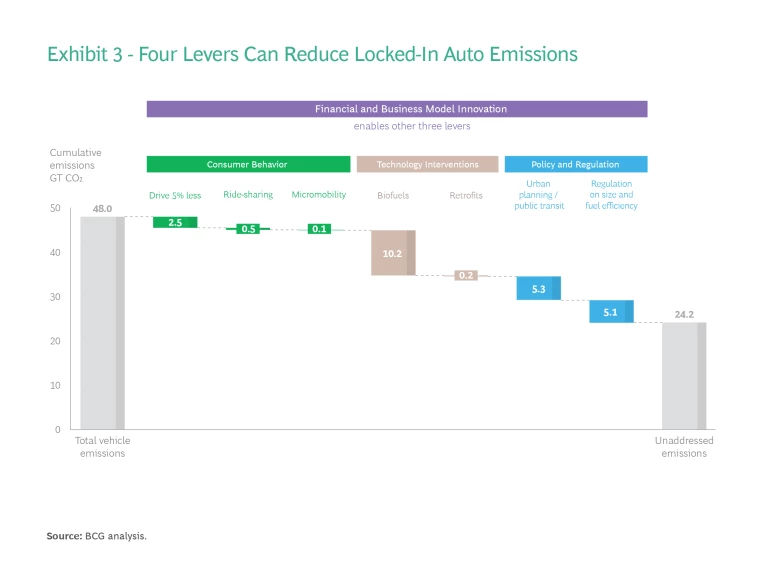
Nudging consumer behavior.
Consumers play an outsized role in transportation sector emissions; their decision to drive less yields immediate impact. Efforts by businesses and cities, for example, can help educate consumers to make greener choices. Companies that offer navigation software can optimize routes for lower emissions, calculate greenhouse gas emissions per trip, and even create games that reward drivers for reducing emissions. And all businesses can encourage employee carpooling and a smart balance between in-person and remote work that helps reduce total emissions related to commuting.
Expansion of micro-mobility (such as bikes, e-bikes, e-scooters) and ride sharing programs, including through corporate and government financial support, can further expand consumer options for low-emission alternatives. For example, expanded e-bike access through Denver’s e-bike rebate program led to a reduction in 100,000 vehicle miles driven per week. However, because micro-mobility and ride sharing can displace other low-emission forms of transit, such as walking and taking public transportation, such nudges must be considered carefully in combination with other public policy objectives.
We estimate that such nudges in consumer behavior could reduce miles driven and reasonably cut auto emissions between now and 2035 by about 6%, or 3.1 GT.
Beyond these established solutions for reshaping consumer behavior, companies can drive additional emission reductions and expand value pools. Among the possibilities:
- Encouraging fuel-efficient and emissions-aware driving practices among owners of older cars through car diagnostic software and apps.
- Expanding ride-sharing services equipped with car seats for families with children, tapping into an attractive, underserved market segment.
- Improving logistics planning software to better integrate a mix of public transit and other low-emissions options, such as ride sharing or city bike shares, and gamify for rewards.
Technological intervention.
Swapping fuel sources or retrofitting vehicles provide another avenue to reduce auto emissions.
For example, biofuels emit 32%–98% less CO2 than gasoline. Several types are already widely available, accounting for ~3% of transport fuels worldwide. Advanced biofuels—those made from feedstocks that don’t compete with food production—have significant room to grow. Expanded access to capital is needed to help overcome the high cost to pilot and scale advanced biofuel production, such as waste-to-fuel technology and algae-based biofuels. However, major oil companies are backtracking on biofuels R&D, which could jeopardize biofuels development and the vehicle emission reductions they can enable.
Retrofitting ICE vehicles with electric power trains could also help reduce emissions. High cost and safety concerns create barriers to widespread adoption of EV car conversions, but several companies have emerged to address this market. A French company, Transit One, has developed conversion kits for a selection of popular cars in Europe. In India, ETrio provides electric car conversions targeting cargo vehicles. US tax credits can even be applied for eligible vehicle conversions.
We estimate that significant expansion of biofuel use and a modest level of vehicle electric retrofits can cut auto emissions between now and 2035 by approximately 20% (10.4 GT).
The appetite for technological innovation is large, and there may be fixes not yet commercialized at scale.
Public policy and regulation.
Governments play a critical role through policy and regulation that can shape consumer behavior and accelerate tech development and deployment.
Strong urban planning—including a focus on and investment support for scaling-up public transit—can create more walkable cities and reduce the need for cars altogether. Public transit use has been in decline, particularly with changes in ridership due to the COVID-19 pandemic. Improving safety and comfort for riders, increasing frequency of buses, expanding routes, providing “last mile” access through bike shares, or providing monetary incentives could all help improve ridership. Unfortunately, this opportunity is often overlooked. The Inflation Reduction Act, for example, offered $7,500 tax credits for EV purchases. This incentive is likely to benefit higher income citizens. In addition, there were no similar tax breaks for riders of public transportation
At the same time, cities can adopt a set of well-coordinated regulations and incentives to reduce transportation emissions, particularly in high-density traffic areas. For example, Singapore, London, and New York have implemented congestion tolls. Cities can further restrict single-occupant transit, parking access, and commuting entry days per vehicles. They can also establish better parking facilities—including on-street or covered parking—for electric bikes, e-scooters, and other forms of micro-mobility. And local governments can establish business incentives that encourage employees to take lower-emissions forms of transportation to work. Our analysis finds that smart urban planning and other steps to expand use of public transportation ridership can cut emissions from autos between now and 2035 by 5.3 GT, or 11%—the equivalent of removing roughly 3% of ICE vehicles from use.
In addition, national or regional regulations that target the size, age, or weight of existing cars can further improve fuel efficiency for the overall fleet of vehicles on the road. Improving average vehicle efficiency by just 10% could eliminate roughly 5 GT of emissions by 2035.
Overall, moderately ambitious public policy and regulation could reduce auto locked-in emissions through 2035 by 21% (10.4 GT). Larger reductions may be possible with more aggressive policies, such as setting phase-out timelines for ICE vehicles, restricting reshipment to other markets, eliminating fossil fuel subsidies, or putting a high price on carbon emissions. Such solutions would need to be crafted in a way that did not exacerbate inequity and put an undue burden on low-income car owners.
Subscribe to our Climate Change and Sustainability E-Alert.
Financial and business model innovation.
Creative financing models, new financial instruments, and business model innovation can play a role in reducing locked-in emissions. In addition, such innovation can further catalyze action across the other three levers—setting up a virtuous circle of CO2 reduction.
This includes everything from how loans are priced to the provisioning of blended finance for transit investments and innovation. We already see creative financing models that support consumer nudges. For example, innovative business models are reimagining “access vs. ownership” for automobiles, either through shared fleets (such as Zipcar) or new leasing programs. But there is room for much greater financial creativity. Car insurance companies can more aggressively adjust rate structures to reward lower vehicle mileage and thus lower carbon emissions. In addition, businesses can expand the use of financing arrangements—including offtake agreements for biofuels or public-private partnerships to support public transit or micro-mobility—to accelerate the pace of locked-in emissions reductions. And municipalities can employ innovations based on public wealth
The path we outline for addressing auto emissions has parallels in other assets, such as power plants, industrial facilities, and commercial and residential buildings. In these sectors, the opportunities, such as changing consumer behavior and fuel swapping, and the challenges, such as barriers to quick scale-up of solutions, are often similar to those observed in the auto sector.
Regardless of the sector, addressing locked-in emissions remains a critical and urgent challenge in efforts to drive the green energy transition. Every ton of carbon emitted today pushes us closer to a climate tipping point with potentially irreparable outcomes and compounded costs.
But locked-in emissions also present an immense opportunity to develop new value pools and competitive advantage. Moreover, this opportunity is not limited to traditional energy or industrial players; it is there for stakeholders throughout the business ecosystem, including governments, financial institutions, and customers. For the business community, reducing locked-in emissions is especially important as it offers an opportunity to expand the business portfolio and drive growth while creating positive change for humanity and the world.

